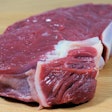
The National Grain and Feed Association (NGFA) and its members are committed to preserving the positive aspects of the North American Free Trade Agreement (NAFTA).
NGFA will “fight tooth and nail to preserve the many positive features of the North American Free Trade Agreement” for U.S. agriculture, while also offering ideas to the Trump administration on how to modernize the 23-year-old trade accord in its effort to modernize and update the deal, NGFA Chairman John Heck, senior vice president of Scoular in Omaha, Nebraska, said recently at NGFA’s 121st annual convention.
NGFA noted that the Trump administration has been receptive to the offer of the NGFA and selective other agricultural organizations to be constructive, proactive partners.
“We have a seat at the table,” Heck said.
John Murphy, senior vice president of international policy at the U.S. Chamber of Commerce, said 14 million American jobs depend on trade with NAFTA members Canada and Mexico.
Murphy noted that the U.S. Chamber is recommending a pragmatic approach to NAFTA renegotiation that improves on the agreement and doesn’t undermine or put at risk any benefits. “We can start doing a better job just by enforcing the agreement as it exists today ... just enforcing what we’ve got would be a big step forward,” he said.
The chairman, president and CEO of Union Pacific, Lance Fritz, echoed that sentiment, noting that NAFTA is critical to the health of the U.S. economy. “NAFTA can be modified and should be modified,” he said. “But vacating the agreement is not the right answer.”
Heck summarized NGFA members’ concerns about investing in infrastructure, particularly waterways and ports. “Given the commitment of the Trump administration to work with Congress to invest significantly in U.S. infrastructure, we have a golden opportunity to front-load investments to jumpstart and expedite construction and rehabilitation of our dilapidated locks and dams, as well as updating of our harbors and ports,” he said.
Working with Trump administration to modernize NAFTA
NGFA recently told WATTAgNet that it is looking forward to working with the Trump administration on trade and other issues that concern the animal feed, grain and agriculture sectors.
Randy Gordon, the association’s president, said NGFA wants to be a partner with the White House on trade negotiations, and welcomes the re-evaluation of regulations President Donald Trump has promised.
“We want to work as a food and agriculture group with the new administration in providing ideas on ways to update and modernize NAFTA,” Gordon said.
“We need to work within the political dynamics that exist today with the new administration,” he added. “Trade is important to agriculture, and we want to be a proactive partner in working with the administration to achieve even greater growth.”
NGFA wants to see the North American Free Trade Agreement (NAFTA) continued, modernized and updated.
“It is very positive that the president didn’t withdraw from NAFTA,” Gordon said. “A withdrawal would have increased tariffs on imports and invited retaliation from” Mexico and Canada.
While the renegotiation of NAFTA opens up the possibilities of change, Gordon said it’s also a good time to concentrate on what works well in the agreement.
“In one sense, it’s an opportunity to work to further improve on what we think is already a pretty good agreement,” he said. “NAFTA was very positive in terms of eliminating tariffs on grain-based and agricultural trade.”
According to NGFA, U.S. agricultural exports to Canada and Mexico have grown from $8.9 billion in 1993 to $38.6 billion in 2015. The U.S. exports an average of $3.7 billion of corn and corn products to Canada and Mexico. In 2015, the U.S. exported $438 million to Canada and $2.44 billion to Mexico. Wheat exports were 500 percent higher in the 10 years after NAFTA than the 10 years preceding. Mexico is the second largest market for U.S. wheat, importing $1 billion per year.

















